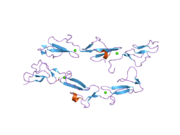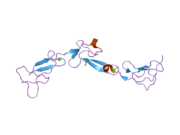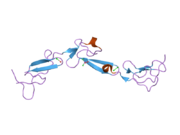CD97
| ADGRE5 | |||
|---|---|---|---|
Gene ontology | |||
| Molecular function | |||
| Cellular component | |||
| Biological process | |||
| Sources:Amigo / QuickGO | |||
Ensembl | |||||||||
|---|---|---|---|---|---|---|---|---|---|
| UniProt | |||||||||
| RefSeq (mRNA) | |||||||||
| RefSeq (protein) | |||||||||
| Location (UCSC) | Chr 19: 14.38 – 14.41 Mb | Chr 8: 84.45 – 84.47 Mb | |||||||
| PubMed search | [3] | [4] | |||||||
| View/Edit Human | View/Edit Mouse |
Cluster of differentiation 97 is a protein also known as BL-Ac[F2] encoded by the ADGRE5 gene.[5][6][7][8] CD97 is a member of the adhesion G protein-coupled receptor (GPCR) family.[9][10] Adhesion GPCRs are characterized by an extended extracellular region often possessing N-terminal protein modules that is linked to a TM7 region via a domain known as the GPCR-Autoproteolysis INducing (GAIN) domain.[11]
CD97 is widely expressed on, among others, hematopoietic stem and progenitor cells, immune cells, epithelial cells, muscle cells as well as their malignant counterparts.[12][13][14][15][16][17] In the case of CD97 the N-terminal domains consist of alternatively spliced epidermal growth factor (EGF)-like domains. Alternative splicing has been observed for this gene and three variants have been found.[7] The N-terminal fragment of CD97 contains 3-5 EGF-like domains in human and 3-4 EGF-like domains in mice.[18]
Ligands
Decay accelerating factor (DAF/
Signaling
Transgenic expression of a CD97 in mice enhanced levels of nonphosphorylated membrane-bound β-catenin and phosphorylated Akt.[24] Furthermore, ectopic CD97 expression facilitated RhoA activation through binding of Gα12/13 as well as induced Ki67 expression and phosphorylated ERK and Akt through enhancing lysophosphatidic acid receptor 1 (LPAR1) signaling.[25][26] Lysophosphatidylethanolamine (LPE; a plasma membrane component) and lysophosphatidic acid (LPA) use heterodimeric LPAR1–CD97 to drive Gi/o protein–phospholipase C–inositol 1,4,5-trisphosphate signaling and induce [Ca2+] in breast cancer cells.[27]
Function
In the immune system, CD97 is known as a critical mediator of host defense. Upon lymphoid, myeloid cells and neutrophil activation, CD97 is upregulated to promote adhesion and migration to sites of inflammation.[28] Moreover, it has been shown that CD97 regulates granulocyte homeostasis. Mice lacking CD97 or its ligand CD55 have twice as many granulocytes as wild-type mice possibly due to enhanced granulopoiesis.[29] Antibodies against CD97 have been demonstrated to diminish various inflammatory disorders by depleting granulocytes.[30] Notably, CD97 antibody-mediated granulocytopenia only happens under the condition of pro-inflammation via an Fc receptor-associated mechanism.[31] Finally, the interaction between CD97 and its ligand CD55 regulates T-cell activation and increases proliferation and cytokine production.[32][33]
Changes in the expression of CD97 have been described for auto-inflammatory diseases, such as rheumatoid arthritis and multiple sclerosis. The expression of CD97 on macrophage and the abundant presence of its ligand CD55 on fibroblast-like synovial cells suggest that the CD97-CD55 interaction is involved in the recruitment and/or retention of macrophages into the synovial tissue in rheumatoid arthritis.[34] CD97 antibodies and lack of CD97 or CD55 in mice reduced synovial inflammation and joint damage in collagen- and K/BxN serum transfer-induced arthritis.[35][36] In brain tissue, CD97 is undetectable in normal white matter, and expression of CD55 is fairly restricted to the endothelium. In pre-active lesion, increased expression of CD55 in endothelial cells and robust CD97 expression on infiltrating leukocytes suggest a possible role of both molecules in immune cell migration through the blood-brain barrier.[37] Additionally, soluble N-terminal fragment (NTF)s of CD97 are detectable in the serum of patients with rheumatoid arthritis and multiple sclerosis.[34]
Outside the immune system, CD97 is likely involved in cell–cell interactions. CD97 in colonic enterocytes strengthens E-cadherin-based adherens junctions to maintain lateral cell-cell contacts and regulates the localization and degradation of β-catenin through glycogen synthase kinase-3β (GSK-3β) and Akt signaling.[24] Ectopic CD97 expression upregulates the expression of N-cadherin and β-catenin in HT1080 fibrosarcoma cells leading to enhanced cell-cell aggregation.[38] CD97 is expressed at the sarcoplasmic reticulum and the peripheral sarcolemma in skeletal muscle. However, lack of CD97 only affects the structure of the sarcoplasmic reticulum, but not the function of skeletal muscle.[17] In addition, CD97 promotes angiogenesis of the endothelium through to α5β1 and αvβ3 integrins, which contributes to cell attachment.[21]
Clinical significance
CD97 expression in cancer was first reported for dedifferentiated thyroid carcinoma and their lymph node metastases.[39] CD97 is expressed on many types of tumors including thyroid, gastric, pancreatic, esophageal, colorectal, and oral squamous carcinomas as well as glioblastoma and glioblastoma-initiating cells.[39][40][41][42][43][44][45] In addition, enhanced CD97 expression has been found at the invasion front of tumors,[46] suggesting a possible role in tumor migration/invasion,[43][46] and correlated with a poorer clinical prognosis.[44][41][42][47][48] CD97 has isoform-specific functions in some tumors. For instance, the small EGF(1,2,5) isoform promoted tumor invasion and metastasis in gastric carcinoma;[49] the small EGF(1,2,5) isoform induced but the full length EGF(1-5) isoform suppressed gastric carcinoma invasion.[50]
Forced CD97 expression induced cell migration, activated proteolytic matrix metalloproteinases (MMPs), and enhanced secretion of the chemokines interleukin (IL)-8.[51] Tumor suppressor microRNA-126, often downregulated in cancer, was found to target CD97 thereby modulating cancer progression.[52] CD97 can heterodimerize with the LPAR1, a canonical GPCR that is implied in tumor progression, to modulate synergistic functions and LPA-mediated Rho signaling.[26][25] It has been shown that CD97 regulates localization and degradation of β-catenin.[24] GSK-3β, inhibited in some cancer, regulates the stability of β-catenin in cytoplasm and subsequently, cytosolic β-catenin moves into the nucleus to facilitate expression of pro-oncogenic genes.[53][54] Because of its role in tumor invasion and angiogenesis, CD97 is a potential therapeutic target. Several treatments reduce CD97 expression in tumor cells such as cytokine tumor growth factor (TGF)β as well as the compounds sodium butyrate, retinoic acid, and troglitazone.[41][42][55] Taken together, experimental evidence indicates that CD97 plays multiple roles in tumor progress.
References
- ^ a b c GRCh38: Ensembl release 89: ENSG00000123146 – Ensembl, May 2017
- ^ a b c GRCm38: Ensembl release 89: ENSMUSG00000002885 – Ensembl, May 2017
- ^ "Human PubMed Reference:". National Center for Biotechnology Information, U.S. National Library of Medicine.
- ^ "Mouse PubMed Reference:". National Center for Biotechnology Information, U.S. National Library of Medicine.
- S2CID 10538838.
- PMID 8786105.
- ^ a b "Entrez Gene: CD97 CD97 molecule".
- PMID 25713288.
- ISBN 978-1-4419-7912-4.
- S2CID 6958640.
- PMID 22333914.
- PMID 18603564.
- PMID 9389316.
- PMID 11380941.
- S2CID 36161414.
- PMID 18941248.
- ^ PMID 24949957.
- PMID 21952799.
- S2CID 21654966.
- PMID 9064337.
- ^ PMID 15576472.
- PMID 22210915.
- S2CID 25515098.
- ^ PMID 20084281.
- ^ PMID 21978933.
- ^ PMID 22797060.
- PMID 23838008.
- PMID 14707087.
- PMID 21984892.
- PMID 21618832.
- S2CID 21436547.
- PMID 16818763.
- PMID 17449467.
- ^ PMID 10211878.
- PMID 17007638.
- PMID 20131275.
- S2CID 23377628.
- S2CID 24457862.
- ^ PMID 9135025.
- PMID 12428789.
- ^ PMID 12414513.
- ^ S2CID 23543805.
- ^ PMID 23658650.
- ^ PMID 24832468.
- PMID 25714433.
- ^ S2CID 24924901.
- PMID 22547928.
- PMID 25624904.
- PMID 22768192.
- PMID 20428763.
- PMID 17071601.
- PMID 24274104.
- PMID 11839557.
- PMID 18023328.
- PMID 15785241.
External links
- GPCR consortium
- Human ADGRE5 genome location and ADGRE5 gene details page in the UCSC Genome Browser.



